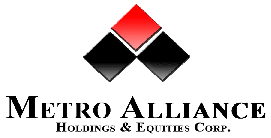



The Company’s risk management is coordinated with the Group, in close cooperation
with the Board of Directors, and focuses on actively securing the short-
The Group’s principal financial instruments consist of cash, AFS investments, due
from (to) related parties and long-
The main risks arising from the Group’s financial instruments are interest rate risk, credit risk and liquidity risk. The BOD reviews and approves the policies for managing these risks which are summarized below:
Interest Rate Risk
The Group’s exposure to the risk of changes in market interest rates relates primarily
to the Group’s long-
Credit Risk
It is the Group’s policy to require all concerned related and/or third party to comply and undergo a credit verification process with emphasis on their capacity, character and willingness to pay. In addition, receivables are closely monitored so that exposure to bad debts is minimized. The Group deals only with legitimate parties. As to other financial assets of the Group like cash, the credit risk arises only in case of default of the counterparty and the maximum exposure is limited to the carrying amount of the instruments.
The credit quality of receivables is managed by the Group using internal credit quality ratings. High and medium grade accounts consist of receivables from debtors with good financial standing and with relatively low defaults. The Group constantly monitors the receivables from these customers in order to identify any adverse changes in credit quality. The allowance for doubtful accounts is provided for those receivables that have been identified as individually impaired.
Liquidity Risk
Liquidity risk refers to the risk that the Company will not be able to meet its financial obligations as they fall due.
The Group’s objective is to maintain a balance between flexibility and continuity
of funding. However, because of the default on the payment of interest and principal
amortizations on existing debts, the Group’s access to funds has been limited to
those of its related parties in the form of advances. Current working capital requirements
will continue to be sourced from short-
Capital Risk Objective and Management
The primary objective of the Company’s capital management is to ensure its ability to continue as a going concern and that it maintains a strong credit rating and healthy capital ratios to support its business and maximize shareholder value.
The Board of Directors have the overall responsibility for monitoring of capital in proportion to risk. Profiles for capital ratios are set in the light of changes in the Company’s external environment and the risks underlying the Company’s business operations and industry.
The Company monitors capital on the basis of the debt-
The Company monitors capital on the basis of the gearing ratio. This ratio is calculated as net debt divided by total capital. Net debt is calculated as total borrowings (including accrued and other payables and advances from related parties as shown in the Company statement of financial position) less cash.
Internal Control System
We have in place an internal audit system whereby the internal audit can conduct
independent and objective internal-

| Our Business |
| Our Company |
| Profile |
| Vision, Mission and Values |
| Board of Directors and Management |
| Organizational Chart |
| Corporate Structure |
| Shareholdings Structure |
| Articles Of Incorporation and By-Laws |
| Manual On Corporate Governance |
| Code of Business Conduct and Ethics |
| Annual Corporate Governance Report (ACGR) |
| Board Committees |
| Corporate Social Responsibility |
| Risk Management |
| Policies |
| SEC Filings |
| Notice of Annual & Special Stockholders' Meeting |
| Minutes of Meetings |
| Other Disclosures to SEC, PSE, etc |
| Investor Relations Program |
| Share Information |
